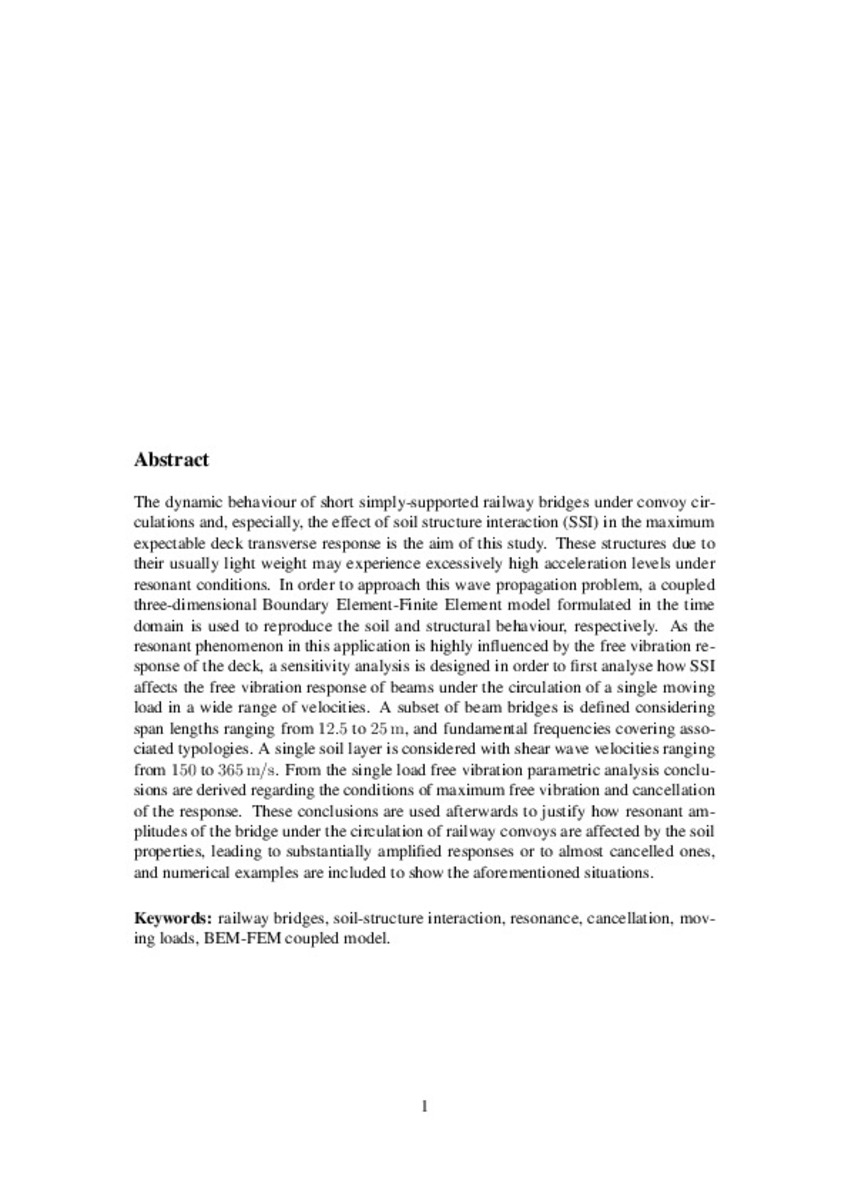Mostrar el registro sencillo del ítem
Analysis of the Effect of Soil-Structure Interaction on the Response of Railway Bridges using Boundary Element - Finite Element Methods
| dc.contributor.author | Doménech Monforte, Alejandro | |
| dc.contributor.author | Martínez-Rodrigo, María D. | |
| dc.contributor.author | Galvín, Pedro | |
| dc.contributor.author | Romero Ordóñez, Antonio | |
| dc.date.accessioned | 2016-05-27T14:44:59Z | |
| dc.date.available | 2016-05-27T14:44:59Z | |
| dc.date.issued | 2016 | |
| dc.identifier.citation | A. Doménech, M.D. Martínez-Rodrigo, P. Galvín, A. Romero, "Analysis of the Effect of Soil-Structure Interaction on the Response of Railway Bridges using Boundary Element - Finite Element Methods", in J. Pombo, (Editor), "Proceedings of the Third International Conference on Railway Technology: Research, Development and Maintenance", Civil-Comp Press, Stirlingshire, UK, Paper 131, 2016. doi:10.4203/ccp.110.131 | ca_CA |
| dc.identifier.isbn | 978-1-905088-65-2 | |
| dc.identifier.issn | 1759-3433 | |
| dc.identifier.uri | http://hdl.handle.net/10234/160056 | |
| dc.description.abstract | The dynamic behaviour of short simply-supported railway bridges under convoy circulations and, especially, the effect of soil structure interaction (SSI) in the maximum expectable deck transverse response is the aim of this study. These structures due to their usually light weight may experience excessively high acceleration levels under resonant conditions. In order to approach this wave propagation problem, a coupled three-dimensional Boundary Element-Finite Element model formulated in the time domain is used to reproduce the soil and structural behaviour, respectively. As the resonant phenomenon in this application is highly influenced by the free vibration response of the deck, a sensitivity analysis is designed in order to first analyse how SSI affects the free vibration response of beams under the circulation of a single moving load in a wide range of velocities. A subset of beam bridges is defined considering span lengths ranging from 12.5 to 25 m, and fundamental frequencies covering associated typologies. A single soil layer is considered with shear wave velocities ranging from 150 to 365 m/s. From the single load free vibration parametric analysis conclusions are derived regarding the conditions of maximum free vibration and cancellation of the response. These conclusions are used afterwards to justify how resonant amplitudes of the bridge under the circulation of railway convoys are affected by the soil properties, leading to substantially amplified responses or to almost cancelled ones, and numerical examples are included to show the aforementioned situations | ca_CA |
| dc.description.sponsorShip | The third and fourth authors would like to acknowledge the financial support provided by the Spanish Ministry of Economy and Competitiveness (Ministerio de Econom´ıa y Competitividad) under the research project [BIA2013-43085-P]. | ca_CA |
| dc.format.extent | 22 p. | ca_CA |
| dc.format.mimetype | application/pdf | ca_CA |
| dc.language.iso | eng | ca_CA |
| dc.publisher | Civil-Comp Press | ca_CA |
| dc.relation.isPartOf | Ponencia presentada en: Railways 2016, The Third International Conference on Railway Technology: Research, Development and Maintenance, Cagliari, Sardinia, Italy 5-8 April 2016 | ca_CA |
| dc.rights.uri | http://rightsstatements.org/vocab/CNE/1.0/ | * |
| dc.subject | railway bridges | ca_CA |
| dc.subject | soil-structure interaction | ca_CA |
| dc.subject | resonance | ca_CA |
| dc.subject | cancellation | ca_CA |
| dc.subject | moving loads | ca_CA |
| dc.subject | BE-FE coupled model | ca_CA |
| dc.title | Analysis of the Effect of Soil-Structure Interaction on the Response of Railway Bridges using Boundary Element - Finite Element Methods | ca_CA |
| dc.type | info:eu-repo/semantics/conferenceObject | ca_CA |
| dc.identifier.doi | http://dx.doi.org/10.4203/ccp.110.131 | |
| dc.rights.accessRights | info:eu-repo/semantics/openAccess | ca_CA |
| dc.relation.publisherVersion | http://www.ctresources.info/ccp/paper.html?id=9022 | ca_CA |







